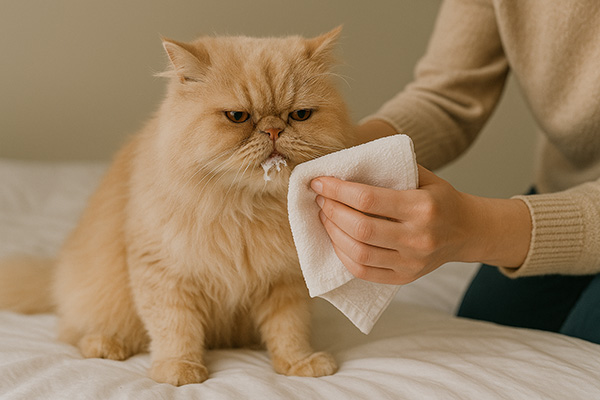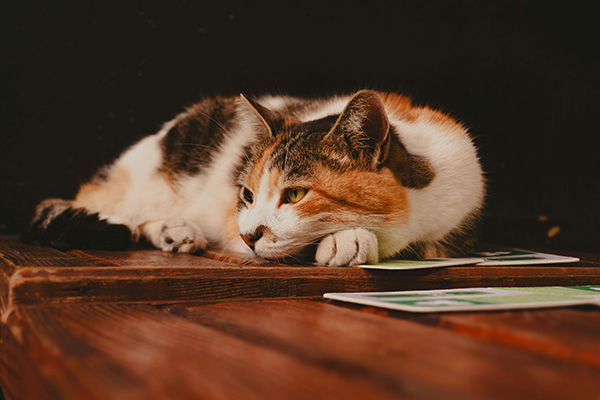Is your cat vomiting white foam? While the occasional hairball might be normal, frequent or sudden episodes of foamy vomit can signal anything from a minor upset stomach to a serious health issue. As a responsible pet owner, it's important to understand possible causes and when to seek help.
In this guide, we’ll break down the top reasons for cat vomiting white foam, the symptoms to watch for, and the steps to help recover your cat's health.
Acute Or Chronic Vomiting
Understanding the difference between acute and chronic vomiting is crucial for diagnosing why your cat throws up white foam. Acute vomiting happens suddenly and lasts a short time, often due to hairballs, dietary mistakes, toxins, infections, or swallowed objects. While a single episode may not be alarming, persistent vomiting over 24 hours, or symptoms like lethargy, blood in vomit, or refusal to eat, require immediate vet attention. In these cases, withholding food briefly and offering water may be helpful, but urgent care is necessary for potential poisoning or blockages.
Chronic vomiting, on the other hand, occurs repeatedly over weeks or months and often signals underlying conditions like inflammatory bowel disease (IBD), kidney disease, hyperthyroidism, or food allergies. These cases usually come with additional warning signs, such as weight loss, increased thirst, or skin irritation. Unlike acute vomiting, chronic cases won’t resolve on their own and demand veterinary testing, like bloodwork or ultrasounds, to diagnose and manage the root cause.
Top Reasons Why a Cat Throwing Up White Foam

Hairballs
If your cat is throwing up white foam, hairballs may be the culprit, especially if your cat is a frequent groomer or has long fur. Most hairball-related vomiting is harmless, but prevention is key to keeping your cat comfortable. If symptoms worsen, consult your veterinarian.
One of the clearest signs of a hairball-related issue is foamy vomit that contains strands or clumps of hair. Before vomiting, your cat may crouch low, gag, or make hacking sounds as they try to expel the hairball. Other mild symptoms can include occasional coughing, reduced appetite, or slight constipation due to fur accumulating in the digestive tract. However, if your cat is otherwise acting normal—eating, drinking, and behaving as usual—the issue is likely just a passing hairball.
To help prevent future episodes, brush your cat regularly to minimize the ingestion of loose fur, especially for long-haired breeds. Hairball-control snacks, specially formulated diets, or veterinarian-recommended lubricants (such as petroleum-based gels) can help pass hair through the digestive tract. Increasing hydration with wet food or a water fountain also helps. If vomiting persists beyond 24 hours, your cat stops eating, or appears lethargic, consult a veterinarian, as severe hairballs can sometimes cause intestinal blockages that require medical attention. With proper grooming and care, most hairball-related vomiting can be managed effectively.
Empty Stomach (Bile Vomiting)
When a cat vomits white or yellowish foam, it may be due to an empty stomach, a condition known as bile vomiting or bilious vomiting syndrome. This occurs when a cat has not eaten for an extended period, causing stomach acid and bile to build up and irritate the stomach lining.
Signs that bile vomiting is the cause include vomiting early in the morning or late at night when the cat hasn’t eaten for hours. The vomit usually appears foamy, white, or yellow, and your cat may seem otherwise healthy, alert, eat normally afterward, and show no signs of illness like lethargy, diarrhea, or weight loss.
To help reduce bile vomiting, pet parents can offer smaller, more frequent meals throughout the day and consider a small snack before bedtime. This keeps the cat’s stomach from staying empty for too long. Using an automatic feeder can help maintain a regular feeding schedule.
However, it's important to contact a veterinarian if your cat continues to vomit, shows signs of worsening, or develops additional symptoms like reduced appetite, low energy, or noticeable behavior changes. Ongoing vomiting may signal a more serious health concern, such as digestive disorders, parasites, or kidney disease. Early veterinary evaluation ensures proper diagnosis and treatment if bile isn’t the only cause.
Gastritis (Stomach Inflammation)
If your cat is vomiting white foam, gastritis (stomach inflammation) may be the cause. This condition arises when the stomach lining becomes inflamed, often triggered by inappropriate eating habits, food sensitivities, infections, or exposure to harmful substances. Key signs of gastritis include repeated vomiting of white or yellow foam, loss of appetite, lethargy, and excessive drooling. Some cats may also exhibit discomfort when their belly is touched or show increased thirst due to dehydration resulting from frequent vomiting.
Monitor your cat's behavior to determine if gastritis is the issue. If vomiting persists beyond 24 hours, is accompanied by blood in vomit, diarrhea, or severe weakness, seek veterinary care immediately, as these could indicate a more serious condition. For mild cases, withhold food for 12 hours (but provide water) to allow the stomach to settle, then reintroduce a bland diet (such as boiled chicken or a prescription gastrointestinal food) in small portions. Veterinarian-prescribed probiotics and anti-nausea medications can also be beneficial.
Prevent future flare-ups by avoiding sudden diet changes, limiting table scraps, and ensuring your cat doesn’t eat spoiled food or foreign objects. If symptoms recur frequently, consult your veterinarian to rule out underlying issues, such as food allergies, parasites, or chronic illnesses. Prompt treatment can support a faster recovery for your cat and reduce the risk of further health issues.
Indigestion or Dietary Issues
If your cat is vomiting white foam, indigestion, or dietary problems could be to blame. This often occurs when cats eat too quickly, consume spoiled food, or undergo a sudden change in their diet. Symptoms include occasional vomiting of white or clear foam, gagging after meals, mild lethargy, or a temporary loss of appetite. Unlike more serious conditions, these episodes are usually short-lived, and your cat may return to normal shortly after vomiting.
To confirm if indigestion is the cause, check for recent diet changes, scavenged food, or eating too fast. You can manage mild indigestion at home if your cat is otherwise active and not exhibiting severe symptoms (such as blood in vomit or prolonged refusal to eat). Hold off on feeding your cat for 4 to 6 hours, while still offering water, then gradually introduce a bland diet like plain boiled chicken or unsweetened pumpkin in small amounts. Slow-feed bowls can help cats that eat too quickly, while a consistent, high-quality diet prevents stomach upset.
If vomiting persists beyond 24 hours or is accompanied by diarrhea, dehydration, or weakness, consult your vet—these could signal food allergies, toxins, or blockages. Preventing future episodes involves avoiding sudden food switches, securing trash, and monitoring treat intake. With proper care, most dietary-related vomiting resolves quickly.
Intestinal Parasites

If your cat is vomiting white foam, intestinal parasites like roundworms, tapeworms, or giardia could be to blame. These pests irritate the digestive system, often causing foamy vomit (sometimes containing worms or mucus), diarrhea, a swollen belly, or visible worm segments in your cat's stool or around their rear. Other warning signs include unexplained weight loss, a dull coat, or excessive grooming of the anal area due to discomfort.
The most definitive way to diagnose parasites is through a veterinary fecal exam, as some worms aren't visible to the naked eye. Left untreated, parasites can lead to serious complications, such as intestinal blockages or malnutrition, particularly in kittens or older cats. If you suspect parasites, schedule a vet visit for proper deworming medication (avoid over-the-counter products, as they may not target all parasite types). Your veterinarian may recommend follow-up treatments and suggest preventive measures, such as regular fecal testing, flea control (since fleas can transmit tapeworms), and thorough cleaning of your cat's environment.
Watch for emergency signs like constant vomiting, extreme lethargy, or signs of dehydration, which require immediate veterinary attention. With prompt treatment and proper prevention, most cats recover fully from parasite-related issues.
Poisoning or Toxin Ingestion
A cat throwing up white foam could be life-threatening if your cat ingested poison or toxins. Unlike other conditions, toxin exposure often causes sudden, severe symptoms, including excessive drooling, white or bloody foam vomiting, tremors, seizures, or difficulty breathing. Your cat may also appear disoriented, lethargic, or collapse unexpectedly. Common household toxins include lilies (extremely deadly to cats), antifreeze, human medications (like ibuprofen), pesticides, or certain essential oils.
If you think your cat may have consumed something toxic, respond immediately. Time is critical. First, try to identify the toxin by looking for chewed plants, spilled chemicals, or missing pills in your home. Immediately call your veterinarian, an emergency animal clinic, or a pet poison control hotline (such as the ASPCA Animal Poison Control at 888-426-4435) for guidance. Never attempt to make your cat vomit unless directed by a veterinarian, as certain toxins can be even more harmful when brought back up. If you can, take a sample of the suspected substance or your cat’s vomit to the vet for evaluation. When transporting your cat, keep them warm and calm, and refrain from giving them food or water unless instructed to do so. Even if your cat seems stable, seek emergency care immediately, as some toxins cause delayed but deadly complications. Keep in mind that prevention is crucial. Be sure to store medications, household chemicals, and poisonous plants where your cat can’t access them.
Without prompt treatment, poisoning can lead to organ failure or death. Even if symptoms seem mild at first, seek emergency care immediately, as some toxins have delayed effects. Keep all hazardous materials securely stored and research cat-safe alternatives for plants and cleaners. The best way to safeguard your cat from accidental poisoning is through prevention.
Bacterial or viral infections
If your cat is vomiting white foam, a viral or bacterial infection could be the underlying cause. Infections like panleukopenia (feline distemper), salmonella, or bacterial gastroenteritis often trigger vomiting along with other concerning symptoms. Watch for yellow or white foamy vomit, high fever, severe lethargy, diarrhea (possibly bloody), and complete loss of appetite. Your cat may also exhibit signs of dehydration, such as sunken eyes and dry gums, or huddle in a crouched position due to abdominal pain.
Viral and bacterial infections require urgent veterinary attention, as they can quickly become life-threatening, particularly in kittens, senior cats, or unvaccinated cats. Keep your cat separated from other pets to prevent possible transmission, and refrain from offering food until a veterinarian gives the go-ahead. Bring your cat to the clinic for diagnostic tests, such as blood work, fecal exams, or PCR testing, and supportive care, including IV fluids, antibiotics for bacterial cases, or antiviral medications. If panleukopenia is suspected, immediate treatment is critical, as this virus has a high mortality rate.
Prevention is key—ensure your cat is up-to-date on core vaccinations (such as FVRCP) and practice good hygiene with food and water bowls. Never ignore persistent cat vomiting with lethargy, as infections can deteriorate rapidly without proper treatment.
Foreign Body Obstruction
If your cat is vomiting white foam, a foreign body obstruction could be the culprit. This occurs when your cat swallows a non-food item—such as string, rubber bands, small toys, or bones—that becomes lodged in the stomach or intestines. Warning signs include chronic vomiting of white or yellow foam, straining to defecate, loss of appetite, lethargy, and abdominal pain (your cat may yowl or resist being touched). You might notice no bowel movements or visible strings/objects protruding from the mouth or rectum in severe cases.
A blockage is a critical emergency that demands prompt veterinary attention. Avoid pulling on any visible strings or objects, which could result in internal injury. Withhold food and water to prevent further vomiting, and take your cat to the vet immediately. Your veterinarian might use X-rays, ultrasounds, or an endoscopy to find the object. Surgery is often necessary to remove it.
Keep small objects, strings, and hazardous items out of reach to prevent reoccurrence. If your cat is prone to chewing, provide safe, vet-approved toys instead. Early intervention is critical—delayed treatment can lead to intestinal rupture, sepsis, or death. If vomiting continues for over 12 hours or is accompanied by severe lethargy, consider it an emergency and seek immediate care.
Chronic Conditions
A cat throwing up white foam can be caused by chronic health issues like chronic kidney disease, liver disease, diabetes, irritable bowel syndrome (IBS), hyperthyroidism, or inflammatory bowel disease (IBD). Unlike acute conditions, these problems develop gradually and often come with ongoing symptoms, including weight loss despite a good appetite, increased thirst and urination, dull coat, and persistent vomiting (often white or yellow foam). Cats with IBD may also have diarrhea or bloody stool, while those with kidney disease might show bad breath and lethargy.
If your cat is vomiting frequently and showing other signs of a chronic illness, schedule a vet visit as soon as possible. Blood tests, urine analysis, ultrasounds, or biopsies may be needed to diagnose the condition. Treatment depends on the condition but may include special diets (e.g., low-phosphorus diets for kidney disease), medications (e.g., insulin for diabetes), or anti-inflammatory drugs for inflammatory bowel disease (IBD).
Long-term management is key—regular vet check-ups, monitoring food and water intake, and adhering to prescribed treatments can help your cat live comfortably. Early detection improves outcomes, so don’t dismiss recurring vomiting as "just hairballs." If not addressed, chronic conditions can result in organ failure or serious complications. Keeping a symptom journal can assist your vet in monitoring progress and making necessary adjustments to treatment.
Stress or Anxiety
Cats are delicate creatures, and stress or anxiety can impact your cat's digestive health, sometimes leading to vomiting white foam. Common causes include shifts in routine, the arrival of new pets or people, loud sounds like construction or fireworks, or even changes in furniture arrangement. Along with foamy vomit, stressed cats may exhibit excessive grooming (leading to bald patches), hiding more than usual, loss of appetite, or inappropriate urination or defecation outside the litter box. Some cats may also become more vocal, clingy, or aggressive when anxious.
First, identify and minimize stressors by providing a quiet, safe space with familiar bedding, toys, and vertical spaces for climbing. Pheromone diffusers (like Feliway) or calming supplements may help reduce anxiety. If vomiting persists, consult your vet to rule out medical causes and discuss anti-anxiety medications if needed. Gradual introductions to new pets or environments can also prevent stress-related vomiting.
Stick to a regular schedule for feeding and playtime, and try to minimize abrupt changes whenever you can. If your cat is prone to anxiety, enrich their environment with puzzle feeders and interactive toys to keep them mentally stimulated. While occasional stress-related vomiting may resolve on its own, chronic anxiety requires attention to ensure your cat's long-term well-being. If symptoms worsen or other concerning signs appear (e.g., lethargy, diarrhea), seek veterinary care promptly.
